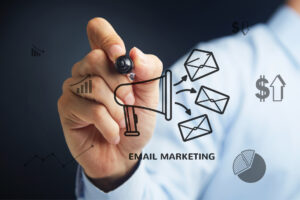
Email marketing is probably the oldest of all digital marketing strategies. It’s based on creating and sending emails to build and develop relationships with prospects and customers. An effective email marketing strategy will convert website visitors into first-time customers and then turn them into repeat customers. Email marketing is flexible, cost-effective, measurable, and time-saving.
But the biggest question is…
Is email marketing still worth it in 2021?
There are a lot of technological advancements - chatbots, artificial intelligence, virtual reality, among others. It may seem like email has been buried 10 feet under.
And so it seems...
But you’re wrong.
According to research, email marketing is still the most effective way to deepen customer relationships for B2B businesses. Over half of the research respondents said that brands should contact them through email.
Are you still wondering why email is still alive and kicking?
I bet because email is still perceived as a private platform. People receive emails from someone they know or from brands they opted in. Hence, it’s somewhat private.
Based on 2019 data, a whopping 90.3% of adult internet users in the United States are using emails. This means that you can use email marketing to whatever age group you’re targeting. Statistics also show that the email open rate is 22.86% versus social media’s engagement rate of only 0.6%.
Email marketing can also give you a high return on investment (ROI) at an average of $38 for every dollar spent.
That’s why building a successful marketing strategy is a must for every business owner. But most people don’t know how to start.
Today, you’ll learn the basics of how to create an email marketing campaign.
Step 1: Lure them to opt-in
How can you send your emails if you don’t have any email addresses?
Ask their permission first so you can send them an email.
As our first step, let’s talk about building your email list.
There are a lot of ways to build your email list. You can give or offer a free something. Whatever it is, be sure that it’s as valuable as your audience’s email address.
For example, web and app developer company MPH International gives simple newsletters in exchange for an email address.
You should think of an incentive for your audience since they are giving you one important piece of information about them - their email address.
Now, here’s where good strong copywriting skills should take place. (I won’t dive into copywriting since I’m not an expert on that.)
Keep in mind that your incentive should lure them to opt-in.
Step 2: Make good on your promise
Email marketing is about staying true to your words.
They gave you their email address, then what?
Promise them something. Lay your cards on the table. Tell them the truth.
For example, in your welcome email, you said you will send newsletters every week. Instead, you bombard them with daily emails. Your audience will be upset.
Moreover, if you said you'd give daily updates but ended up sending updates monthly, then, your audience will also be upset.
So, just deliver. Okay?
The welcome email is the key. It might be long and boring but make sure you set your audience’s expectations straight. Say - ehm, write - everything your audience needs to know. Be as detailed as you can. Don’t leave a question unanswered.
From here, just make sure you live up to what you said and make good on your promise.
But…
When do I pitch for a sale?
We all know that you’re not sending emails just because, right? In “we” I mean you, I, and your audience. Yes, your audience included.
When they are first opt-in, they get something they need from you for free (the incentive). So, they also know that somewhere along the way you will ask them to buy or pay for something.
But transitioning from a friendly update with a lot of free stuff into a sales-y email can be tricky.
To help you out, plan.
Think about how you will pitch for the sale even before building your email list. Then, put this on your welcome email. So, your audience knows.
You can put a CTA button on every email you send. You can send sales emails in a planned frequency - like once a month. All up to you.
Just make sure you pitch your sale.
Don’t go around sending shady or blind offers. Be direct.
Now that you understand the basics of building a successful email marketing campaign, you can level up by learning segmentation and analytics (which I won’t discuss here due to lack of time. charot!).
So, just to give you an overview let me define segmentation and analytics.
Segmentation is dividing your email list into targeted groups. For example, you can group your email list by who opened and who did not. Then, you can send a different email for each group. There can be different ways of communicating with your audience. For example, you give daily updates and weekly newsletters with discounts. Some of your audience would love the daily and weekly communication but some will favor one over the other. You can also group them by segmentation.
Analytics, on the other hand, will help you measure your email marketing campaign’s success. For me, the two most important are open rate and click-through rate. Open rate will tell you if you built a good relationship or not. Click-through rate or CTR will tell you how many clicks your CTA (or other links) got.
To wrap up…
Is your email marketing always pushed aside? Maybe it’s time to reevaluate.
More so today, email marketing promises good results and high returns.
Start now. Start today.
It doesn’t have to be complicated. It’s not rocket science.
It is work - yes.
Remember, doing it right will separate you from the rest who just do it for the sake of.
 You’re feeling ecstatic. You just started your dream business.
You’re feeling ecstatic. You just started your dream business.
You have done setting up your physical store, distributed the flyers, and installed posters within your vicinity. You did your homework. Your product or service has high quality, your price is on par with the competition, and there’s a demand for it. You know that this business would work. Yes, finally, your business is now ready for primetime.
However, after a couple of months of operation, you’re disappointed with your sales.
How is that possible you may ask?
There’s a ton of potential reasons but one of the biggest culprits is marketing. In today’s internet age, it’s Digital Marketing to be exact.
Business owners, you may just be missing the known secret of modern business’ virality and success.
DIGITAL MARKETING
The fundamentals of marketing haven’t changed – it’s still giving potential clients the emotional and rationale reasons to purchase your product or service. What changed is how businesses MUST do it.
Digital marketing is one the result of those changes due to widespread use of internet and digital devices. As our behavior in doing business becomes more internet-propelled, so does marketing.
Basically, any marketing or activities done to reach customers over the internet is considered as digital marketing. It leverages familiar channels like social media, email, website, and search engine to connect to your target audience.
HOW DIGITAL MARKETING HELPS SMALL AND MEDIUM BUSINESS?
Doesn’t matter if you just started your business or an established medium-sized business, there is a huge and untapped potential in digital marketing.
Do you want to connect to customers outside your city? How about providing convenient support for your customers? Do you want to grow your sales quickly? Then go for digital marketing.
Marketing through the internet provides you the ability to tap thousands of customers over the internet instantly. Though flyers and posters still work, in some ways, it can’t keep up with the flexibility and cost-effectiveness of its digital version.
Flexibility. Traditional marketing requires you to work with physical resources like printed collaterals, brochures, bill boards and the like. If you have the budget, ads for radio and tv commercials could be an option. All of them require significant investment in terms of planning, time, and budget since you have to do it right the first time. Because when they’re out for display, you can’t change them anymore.
In digital marketing, you only need an internet connection, an account in Facebook, and a business page, then you can start reaching your customers. And with the increasing number of internet users each year, the more people you can connect and market your business.
Furthermore, unlike traditional marketing, digital marketing enables you to update your marketing collaterals – digital flyers, social media posts, website headlines -- easily and quickly based on real-time customer behavior. Yes, you can do instantaneous analysis of your online marketing efforts with the right tools which is non-existence in traditional marketing.
Cost-Effective. Any type of business would prefer low cost investment with high returns. That’s even true for small and medium businesses. This makes digital marketing even attractive.
Let me try to share with you some sense of optimism.
For example, in social media, spend only $5 and reach 1,000 people. That’s 3X less costly than traditional media. When you advertise in Search Engine, commonly known as Pay-Per-Click, business average revenue per dollar spent is $2 which is a 200% ROI. Now, you see?
Those were just two out of many digital marketing channels. Based on your business goals and strategy, you have a number of channels to choose from.
WHICH DIGITAL MARKETING STRATEGY IS BEST?
Here are some common strategies:
- Business Website
- Search Engine Optimization (SEO)
- Content Marketing
- Social Media Marketing
- Email Marketing
They all have the same objective – connect your product and services to your audience – but different in approach and use.
Here are a few examples.
For starters, especially for new business owners, creating social media is a quick way of sharing your business to the world. That’s because it’s accessible and a cheap way to advertise your product or service. Social media platforms like Facebook, Instagram, and Pinterest provides an easy way to create a business page and advertise your posts.
To formally bring your business in the digital space and boost your credibility, a business website is your best friend.
There are online services that can help you DIY a website but for quality results I would honestly recommend to ask professionals to do it for you. Why? It brings me to my next point – SEO. No DIY tool can do it right and in a sustainable manner for you.
SEO is crucial to make sure that people can find your website. It assures that your website has the technical requirements and the right content so search engines like Google can serve your website to the right audience.
As you can see. Your digital marketing can contain different strategies and channels to maximize its effectiveness. It’s important that you plan ahead and make sure that your strategy is aligned with your business goals.
Basically, each digital marketing strategy is best in their own right.
WHERE DOES THIS LEAVE US?
Those are just a few but real reasons why digital marketing is the norm these days.
Having a solid digital marketing plan for your business is a must to spur growth for your business. So, take your time to choose which strategy is best for your current goals. It should be accessible and should bring the most bacon to your business.
Go ahead and get your feet wet. You MUST adapt to the trend or risk to lose hundreds of thousands of potential customers just sitting in the subway.
If you need marketing assistance or you just want to focus on what you do best – building your product or service – give us a ping. Me and my team would be glad to help you.



